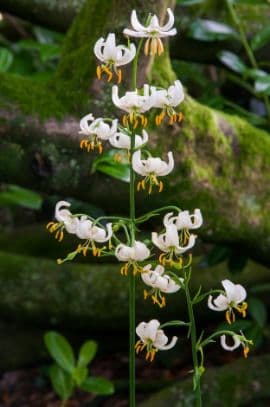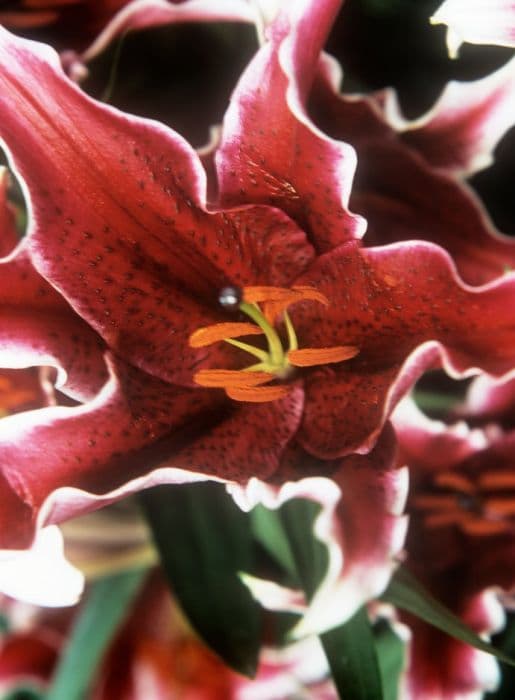Greenland Tulip Tulipa 'Groenland' (8)

ABOUT
Tulipa 'Groenland', commonly known as the Greenland tulip, is a captivating plant admired for its floral beauty. The Greenland tulip is cherished for its elegant flowers which are cup-shaped and boast a delightful color palette. Each flower exhibits a blend of soft pinks, greens, and creamy hues, marked by irregularly distributed streaks or feathering, giving it a unique and artistic appearance. The petals are substantial and overlapped, creating a sturdy and rounded flower form that epitomizes the classic tulip silhouette. As the blooms mature, they may open widely under bright sunshine, revealing their exquisite internal design. The leaves of the Greenland tulip are also noteworthy. They are typically a rich, glossy green and have a lance-shaped or elongated appearance, which gracefully arches and clumps at the base of the stem. The foliage may have a slight wavy texture or a smooth finish that gleams in the sunlight, adding to the overall visual allure of the plant. In harmony, these characteristics form an image of the Greenland tulip that exudes both refinement and a captivating burst of springtime color.
About this plant
 Names
NamesSynonyms
Greenland Tulip, Ice Cream Tulip
Common names
Tulipa 'Groenland'.
 Toxicity
ToxicityTo humans
Tulip 'Groenland' is not highly toxic to humans, but ingestion of any parts can cause mild discomfort. Symptoms of poisoning upon consumption could include nausea, vomiting, or diarrhea. Ingesting large quantities may lead to more severe reactions, but such instances are rare. It is advisable to avoid eating tulip bulbs or any part of the plant.
To pets
Tulip 'Groenland' can be toxic to pets, especially cats and dogs, if ingested. The bulb of the tulip is the most toxic part. Symptoms of tulip poisoning in pets can include gastrointestinal irritation, drooling, loss of appetite, vomiting, or diarrhea. In severe cases, ingesting a large amount of the bulb could lead to more serious conditions, such as an increase in heart rate, changes in respiration, or even convulsions. It is important to seek veterinary care if you suspect your pet has ingested any part of a tulip 'Groenland' plant.
 Characteristics
CharacteristicsLife cycle
Perennials
Foliage type
Deciduous
Color of leaves
Green
Flower color
Pink
Height
1-2 feet (30-60 cm)
Spread
6 inches (15 cm)
Plant type
Bulb
Hardiness zones
3
Native area
Central Asia
Benefits
 General Benefits
General Benefits- Visual Appeal: The Tulipa 'Groenland', commonly known as the Greenland Tulip, has attractive greenish-pink flowers that can enhance the aesthetic of gardens and landscapes.
- Pollinator Attraction: The blooms of the Greenland Tulip can attract beneficial pollinators like bees and butterflies, which are essential for the pollination of many plants.
- Seasonal Interest: Greenland Tulips bloom in spring, providing seasonal interest and color after the winter months.
- Easy to Grow: They are relatively easy to cultivate, making them suitable for gardeners of all skill levels.
- Versatility: These tulips are versatile and can be used in flower beds, borders, containers, and as cut flowers in floral arrangements.
- Cultural Significance: Tulips, including the Greenland variety, have a historical and cultural significance, often symbolizing the arrival of spring and renewal.
- Property Value: Attractive gardens and landscaping with colorful tulips like the Greenland can contribute to the overall curb appeal and value of a property.
- Gardening Satisfaction: Growing and successfully blooming tulips such as the Greenland can provide gardeners with a sense of accomplishment and satisfaction.
 Medical Properties
Medical PropertiesThis plant is not used for medical purposes.
 Air-purifying Qualities
Air-purifying QualitiesThis plant is not specifically known for air purifying qualities.
 Other Uses
Other Uses- Crafting bespoke jewelry - The petals of tulips can be pressed and preserved in resin to create unique and colorful pieces of jewelry.
- Dye production - Tulip petals, especially from Tulipa 'Groenland', can be used to create natural dyes for fabrics and textiles.
- Eco-friendly confetti - Dried tulip petals are biodegradable and can be used as a vibrant alternative to traditional paper confetti at events and celebrations.
- Bookmark decoration - Pressed tulip petals can be used to make attractive and decorative bookmarks.
- Gourmet cuisine - Edible tulip petals can be crystallized with sugar and used to garnish or add flair to desserts and sweet dishes.
- Botanical art - Pressed and dried, tulip petals can be arranged into framed botanical art pieces.
- Natural potpourri - Dried tulip petals can be mixed with other natural ingredients to create fragrant potpourri for scenting rooms.
- Candle adornments - Petals from the tulip can be embedded into homemade candles to add a unique and floral aesthetic.
- Photography subjects - With their striking colors and shapes, tulips serve as excellent subjects for still life and macro photographers.
- Signature cocktails - For a touch of elegance, tulip petals can be floated in cocktails or infused into spirits for a floral note.
Interesting Facts
 Feng Shui
Feng ShuiThe Tulip is not used in Feng Shui practice.
 Zodiac Sign Compitability
Zodiac Sign CompitabilityThe Tulip is not used in astrology practice.
 Plant Symbolism
Plant Symbolism- Perfect Love: The Tulip 'Groenland', commonly known as Tulip, often symbolizes perfect, deep, or true love, reflecting the idea that this flower embodies a love that is almost ideal in its nature.
- Declaration of Love: Giving a Tulip can be seen as a bold declaration of one's love, as these flowers have historically been used to express one's feelings for another.
- Rebirth and Renewal: As a herald of spring, Tulips, including the 'Groenland', represent rebirth and new beginnings, making them perfect for celebrating significant life changes or the start of a new chapter.
- Royalty: With their upright posture and varied colors, Tulips can convey a sense of regality and elegance, suggesting a noble bearing or stature.
- Prosperity: In some cultures, Tulips are associated with abundance and prosperity, potentially due to their historically high value during the tulip mania period in the Netherlands.
 Water
WaterTulips, including the 'Groenland' variety, should be watered thoroughly when the soil feels dry to the touch during their active growth period. They require a moderate amount of water, which translates to about 1 inch of water weekly, whether through rainfall or manual watering. To prevent overwatering, ensure the soil is well-draining to avoid soil waterlogging, which can cause bulb rot. During dormancy, after the foliage has died back, watering should be reduced and kept to a minimum as the bulbs are resting. It's generally recommended to water tulips with about a half-gallon for each square foot of soil every week during their growing season.
 Light
LightTulips, like the 'Groenland', thrive best in full sun to light shade conditions. Ideally, they should receive at least six hours of direct sunlight each day. Planted tulips will perform best when situated in an area where full morning sunlight is available and some afternoon shade can help protect from the intense heat in very warm climates.
 Temperature
TemperatureThe Groenland Tulip prefers cool temperatures and is best suited to climates with a pronounced winter season. They typically require a winter chill to bloom, with ideal temperatures for planting ranging from 35 to 55 degrees Fahrenheit. Tulips can survive winter temperatures as cold as 14 degrees Fahrenheit, but actively growing plants should be protected from frosts and freezes. The ideal temperature for tulip growth is between 60 and 70 degrees Fahrenheit during the day and cooler at night.
 Pruning
PruningPruning Tulips such as 'Groenland' mainly involves removing the spent flowers to prevent seed formation, which can reduce next year's bloom energy. Cut back the flower stalks after bloom but leave the leaves until they yellow and die back naturally, usually about six weeks after flowering. This allows the tulips to gather energy for next year's growth.
 Cleaning
CleaningAs needed
 Soil
SoilGreenland Tulips thrive in well-draining soil with a neutral to slightly acidic pH of 6.0 to 7.0. A mix of three parts loamy soil to one part sand and one part compost or aged manure is ideal for promoting healthy growth and ample flowering.
 Repotting
RepottingGreenland Tulips are perennial bulbs and do not require repotting. They should be planted in the ground or outdoor containers and allowed to go dormant annually after flowering, only to be divided every 3-5 years if necessary.
 Humidity & Misting
Humidity & MistingGreenland Tulips prefer a moderately dry climate and do not require high humidity levels; they are best cultivated outdoors where natural humidity levels are sufficient for their growth.
 Suitable locations
Suitable locationsIndoor
Place in bright, indirect light and cool room.
Outdoor
Plant in fall, full sun, well-drained soil.
Hardiness zone
3-8 USDA
 Life cycle
Life cycleThe Tulipa 'Groenland', commonly known as Greenland Tulip, begins its life cycle as a bulb planted in autumn before the first frost. During the winter, the bulb undergoes a period of chilling required to break dormancy. Come spring, the bulb roots and shoots start to grow, eventually developing into a stem, leaves, and a distinctive flower typical of tulips, with Greenland Tulip showcasing variegated, streaked petals. After blooming in late spring, the plant directs energy into the bulb for next year's growth as the foliage dies back in early summer. The bulb remains dormant through summer and may multiply by producing smaller bulb offsets, or bulblets. The cycle recommences in autumn with the planting of new or stored bulbs.
 Propogation
PropogationPropogation time
Spring
Propogation: Tulip 'Groenland', a popular spring-flowering bulb, is most commonly propagated through the division of its bulbs. The ideal time to propagate tulips by bulb division is in the fall, after the foliage has died back and the bulb has gone dormant, typically from September to October. To propagate tulips by bulb division, carefully dig up the bulbs without damaging them, gently separate any small bulblets from the mother bulb, and replant them immediately. The smaller bulbs should be planted about 6 to 8 inches (15 to 20 centimeters) apart and at a depth of roughly 6 inches (15 centimeters). This allows the new bulbs sufficient space to grow and enough depth to protect them from harsh winter temperatures.




![Lily [Roselily Chelsea]](/_next/image?url=https%3A%2F%2Fplants-admin.emdemapps.com%2Fimages%2Fplants%2F%2Fimages%2F604b584f6f830.png&w=640&q=75)




